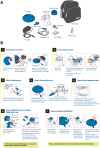Glycopyrrolate/eFlow CS: The First Nebulized Long-Acting Muscarinic Antagonist Approved to Treat Chronic Obstructive Pulmonary Disease
- PMID: 30175596
- PMCID: PMC6357169
- DOI: 10.1177/1060028018798753
Glycopyrrolate/eFlow CS: The First Nebulized Long-Acting Muscarinic Antagonist Approved to Treat Chronic Obstructive Pulmonary Disease
Abstract
Objective: To review the pharmacology, efficacy, and safety of the first nebulized long-acting muscarinic antagonist (LAMA), glycopyrrolate (GLY)/eFlow closed system (CS) nebulizer, approved for maintenance treatment of chronic obstructive pulmonary disease (COPD).
Data sources: A PubMed search was conducted (January 2000 to July 2018) using the following terms/phrases: nebulized glycopyrrolate, inhalation devices in COPD, long-acting muscarinic antagonists COPD, and COPD survey. Retrieved articles were reviewed to identify additional references.
Study selection and data extraction: Primary and review articles on GLY/eFlow CS and other treatment options for patients with COPD were selected.
Data synthesis: Guidelines recommend the use of LAMAs, alone or in combination with long-acting β2-agonists, as maintenance therapy for the majority of patients with COPD. With the range of different devices and bronchodilators now available, treatment can be tailored based on individual needs. The eFlow CS nebulizer delivers GLY rapidly over a 2- to 3-minute period and provides bronchodilation within 30 minutes, lasting 12 hours. Phase 2 dose-finding and phase 3 studies demonstrated sustained statistically significant and clinically important improvements in pulmonary function and patient-reported outcomes with GLY/eFlow CS. Relevance to Patient Care and Clinical Practice: GLY/eFlow CS provides a novel, portable, efficient, and rapid drug delivery system.
Conclusions: The recently approved GLY/eFlow CS drug-device combination provides a viable treatment option for patients with COPD, particularly those with conditions that may impair proper use of traditional handheld inhalers.
Keywords: anticholinergics; bronchodilators; chronic obstructive pulmonary disease; drug development and approval; inhalers; pharmaceutical care.
Conflict of interest statement
Figures



Similar articles
-
Satisfaction with the Use of eFlow Closed-System Nebulizer in Patients with Moderate-to-Very Severe Chronic Obstructive Pulmonary Disease: Findings from a Long-Term Safety Study.J Aerosol Med Pulm Drug Deliv. 2019 Feb;32(1):24-33. doi: 10.1089/jamp.2018.1477. Epub 2018 Nov 17. J Aerosol Med Pulm Drug Deliv. 2019. PMID: 30457433 Clinical Trial.
-
An overview of glycopyrrolate/eFlow® CS in COPD.Expert Rev Respir Med. 2018 Jun;12(6):447-459. doi: 10.1080/17476348.2018.1476853. Epub 2018 May 28. Expert Rev Respir Med. 2018. PMID: 29774778 Review.
-
Long-term safety of glycopyrrolate/eFlow® CS in moderate-to-very-severe COPD: Results from the Glycopyrrolate for Obstructive Lung Disease via Electronic Nebulizer (GOLDEN) 5 randomized study.Respir Med. 2017 Nov;132:251-260. doi: 10.1016/j.rmed.2017.08.020. Epub 2017 Aug 24. Respir Med. 2017. PMID: 28919143 Clinical Trial.
-
Efficacy and safety of glycopyrrolate/eFlow® CS (nebulized glycopyrrolate) in moderate-to-very-severe COPD: Results from the glycopyrrolate for obstructive lung disease via electronic nebulizer (GOLDEN) 3 and 4 randomized controlled trials.Respir Med. 2017 Nov;132:238-250. doi: 10.1016/j.rmed.2017.07.011. Epub 2017 Jul 19. Respir Med. 2017. PMID: 28838685 Clinical Trial.
-
Role of Long-Acting Muscarinic Antagonist/Long-Acting β2-Agonist Therapy in Chronic Obstructive Pulmonary Disease.Ann Pharmacother. 2017 Aug;51(8):696-705. doi: 10.1177/1060028017705149. Epub 2017 Apr 14. Ann Pharmacother. 2017. PMID: 28410560 Review.
Cited by
-
In Vitro Effect of Different Airflow Rates on the Aerosol Properties of Nebulized Glycopyrrolate in the eFlow® Closed System and Tiotropium Delivered in the HandiHaler®.Pulm Ther. 2020 Dec;6(2):289-301. doi: 10.1007/s41030-020-00125-6. Epub 2020 Aug 18. Pulm Ther. 2020. PMID: 32809156 Free PMC article.
-
Drug Permeability: From the Blood-Brain Barrier to the Peripheral Nerve Barriers.Adv Ther (Weinh). 2023 Apr;6(4):2200150. doi: 10.1002/adtp.202200150. Epub 2023 Jan 18. Adv Ther (Weinh). 2023. PMID: 37649593 Free PMC article.
-
Efficacy of Nebulized Glycopyrrolate on Lung Hyperinflation in Patients with COPD.Pulm Ther. 2021 Dec;7(2):503-516. doi: 10.1007/s41030-021-00166-5. Epub 2021 Jul 7. Pulm Ther. 2021. PMID: 34232493 Free PMC article.
References
-
- Global Initiative for Chronic Obstructive Lung Disease (GOLD). Global strategy for the diagnosis, management and prevention of chronic obstructive pulmonary disease: 2018 report. https://goldcopd.org/wp-content/uploads/2017/11/GOLD-2018-v6.0-FINAL-rev.... Accessed August 17, 2018. - PubMed
-
- MacNee W. Pathology, pathogenesis, and pathophysiology. BMJ. 2006;332:1202-1204. doi:10.1136/bmj.332.7551.1202 - DOI
-
- Hoyert DL, Xu J. Deaths: preliminary data for 2011. Natl Vital Stat Rep. 2012;61:1-51. - PubMed
-
- Murphy SL, Xu J, Kochanek KD, Curtin SC, Arias E. Deaths: final data for 2015. Natl Vital Stat Rep. 2017;66:1-75. - PubMed
Publication types
MeSH terms
Substances
LinkOut - more resources
Full Text Sources
Other Literature Sources
Medical

